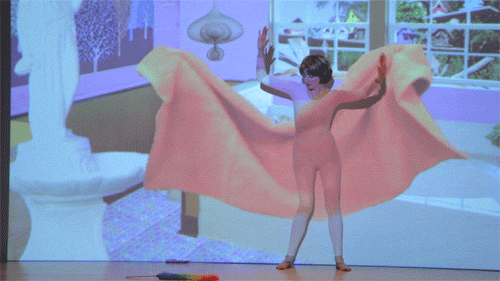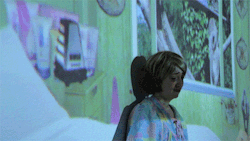“I have a sort of fear of psychedelics”: Shana Moulton At Primary

Scientific research into psychedelic drugs, the everyday miracle of flying and dollar store trinkets: Wayne Burrows talks to Brooklyn-based Californian artist Shana Moulton about the inspirations behind her “hallucinatory” performances and her recent residency at Primary, Nottingham…
Shana Moulton grew up in Oakhurst, California, in a mobile home on the edge of Yosemite National Park, and she currently lives in Brooklyn, New York.
Since 2002 she has been making hallucinatory films, performances, installations and sculpture, often centred on an alter-ego named Cynthia, an idiosyncratic everywoman on a quest for enlightenment through consumer products, New Age spirituality and prescription medicines.
Her residency in the Multiple Points In This Crude Landscape series at Primary, Nottingham, culminated in a new performance earlier this month.
The Double Negative: I’m curious about the relationship between Shana Moulton and Cynthia in the work – she seems to have a way of doing things you couldn’t or maybe wouldn’t do yourself.
Shana Moulton: Absolutely, Cynthia is a way to have some distance. Even though in some ways Cynthia is really just me wearing a wig — she’s not someone who has separate biographical details — she is also a means to execute those ideas that for whatever reason I can’t seem to do in my own persona. And because she’s always there, inside the things I’ve made, I think I also need her to mediate what I’m doing. I’m not just showing psychedelic imagery, I’m also showing Cynthia getting into it, so the audience is invited to see and experience the work with her. She’s important in all sorts of ways I can’t or maybe don’t want to define.
There’s also that question of whether the new age and consumer imagery you use is material you’re advocating or something you’re making a critique of — and if you were present in the work as Shana Moulton instead of Cynthia we’d expect some position representing your own to be visible. Cynthia seems to allow you to to give almost nothing away about how you personally view the things you reference.
I hadn’t thought of it quite like that but, yes, I always feel very on the line about that whole question. I’m very sceptical about this stuff but I’m also fascinated by it and completely open to it. The core of what I want to communicate is that you can be both very sceptical and a sort-of believer in these things, you don’t always have to put yourself on one side of that line or the other.
The performance at Primary felt like there was a narrative, the sort of thing you’d normally expect to see on an altar-piece about the journey of the spirit from the earthly and mundane to the heavens… but because it’s all done through consumer products, you seem to be exploring the idea of consumerism itself as a spiritual quest.
I think that for me, it really is — it’s all I’ve ever known. Growing up, some of the most exciting experiences were things like going to after-Christmas sales with my mother and aunt, where there’d be amazing objects on sale, and that was the elational experience, to find and sometimes even buy those objects. So I do feel like that kind of consumer experience is the spirituality of our time, and I am trying to connect that experience of consumerism I had growing up with the things I’ve learned since about various spiritualities and religious practices. That’s probably my main aim.

At the beginning of this new performance, your hands and voice present a selection of decorative balls and a wooden spiral ‘end-piece’ ornament to the audience. It’s done in a way that seems suggestive of both the QVC shopping channel and a sacred rite.
Yeah, but you know, just look at those decorative balls! They are amazing — exactly the kinds of things my mom or aunt would have in their homes, woven and textured balls that really seem to have something ritualistic embedded in them. Even though they are just cheap dollar-store décor items, their character is very strong and it does feel like they might have some history in pagan lore or tradition somewhere.
The way you use these objects seems to have some kind of class dimension to it. I don’t know the precise nuances of the US class system, but I’ve always imagined that the kind of trailer park you grew up in and used as the setting for Whispering Pines equates roughly to something like a UK council estate in class terms. Are the kinds of people who would decorate their homes with these objects seen as coming from the poorer end of the US class spectrum?
Yes, though class is different in California — it’s like boom and bust, one minute you might be very rich, living in a big house, the next very poor, living in a trailer park. As I’ve moved East I’ve noticed it gets a lot more rigid and the class hierarchies become much more fixed, but I’m not sure what class I’m from myself because of that fluidity in California, so where exactly I fit on that scale is hard to fix. But because I grew up in a senior mobile home park, the thing I most strongly remember as a child is how the objects the elderly people decorated their homes with felt very altar-like, with even the cheapest plastic items having some kind of aura around them.
In those homes, objects like these have the same function as high art objects, just in a different context to the one that’s usually acknowledged. I can imagine that wooden spiral ‘end-piece’ – which probably came from a chain store – cast in bronze and blown up in size. It could be the maquette for a two million-dollar sculpture outside a corporate headquarters.
That piece is amazing, right? I love that spiral end-piece thing. We have a store in the US called Ross, which is kind of like the TK Maxx you have here, and I found this similar spiral sculpture piece there, which was covered in brown mosaic patterns. I got it for my mom, and yeah, I’m kind of genuinely in awe of this thing because it’s so gorgeous. And for me those store bought objects really are more interesting than a lot of things I see in museums and art galleries.
You’ve also been drawn to the sculptural forms of medical equipment – things like neck braces and supports. They were used in this performance to define the dancing body in one of the projected sequences.
Yeah, there was the medical arm-chair with the lifting mechanism, too. The reason I bought that in Nottingham was because my grandmother had one and, when she passed away, my parents offered the chair to a good friend of theirs who had lost his leg from cancer. When he came to the house to look at it, he said: ‘Your Grandma, she doesn’t want me to have this chair’. That was that. But it suggested these kinds of objects can become haunted in some way, they can take on something of the character of the people who used them.

It did feel like the Cynthia projection was both on and inside the chair at the same time, which suggested that haunted aspect. But it seems that your narratives are built around these objects, and the work is really interested in changing the way we look at them.
I guess that’s going back to that elational experience of shopping I talked about having as a child. Half my time in Nottingham for this residency I seem to have spent shopping – going around places looking for things, so when I did find something like that medical chair in the British Heart Foundation shop I knew right away it would be the centrepiece of the new work.
There are also clothes, which perform and become animated in this piece. The skirt you were wearing looked like a Magic Eye pattern…
It’s not, I wish it was a Magic Eye but it’s just a blue marbled pattern, and I found it here, along with a grey marbled shirt. The patterns had a glitchy quality to them that I liked. But there is an important thing in this piece about the body, the whole process of becoming embodied and disembodied, so that was all there in the clothes, the surgical braces, the chair and other things.
Rather than buying objects you’ve scripted into the work, it seems the work is a response to the objects you find. When you made those early medicalised clothing sculptures, did they come before or after the performances that included them?
The costumes came first because the impetus behind them was simply wanting to see what those medical devices looked like attached to clothing and covered in the same fabrics. It was mostly a tactile thing I was interested in at the start. Then I started to imagine the kind of character who might need to wear them — which was really the beginning of Cynthia. I nearly always start by gathering things together and lining it all up because I never know what I’m doing until I’ve lined up some objects, made some video, and gone through a process of testing my own responses to all the different elements I’ve collected. It’s usually fairly late in that process when it all comes together and I know what the work is probably going to be.
Another thing I found fascinating was the technical side, because it looks very makeshift on one level, but is also incredibly precise. There’s a sequence in this performance where you’re dancing, and the dance moves look slightly shonky, but are so precisely matched to the projection behind you that they’re clearly not shonky at all.
Yeah, it’s nice to do that because when you’re not a very good dancer, like me, or even a very strong person physically in general, it’s always possible that just by lining things up in the right way I can still create some magic from this very imperfect body.

It also works thematically, because the projected body you’re dancing with at that point is made entirely out of surgical appliances — things designed to perfect or change the body.
Yeah, I worry that I’m predicting my own future by using all these medical devices because I’m sure I’ll probably need ‘em all at some point. The only thing I’ve really had problems with so far is carpal tunnel, and I’ve had to wear wrist braces for that, but I feel that having had carpal tunnel and had to focus that way on posture and uprightedness has informed the work. It’s that constant sense of a struggle against gravity just to stay upright, so yeah, that’s already happening.
With the Primary residency, did you find it diverged from your usual ways of working?
It was difficult, because with my job in Germany there was so much coming back and forth — and there was an idea in the beginning that I was going to buy all this fabric and make a giant fabric structure, but that didn’t happen. I quickly realised that the space was unique and when I saw how projections were working in there, I thought ‘this is a once in a lifetime thing’.
I’d also read the interview with Edwin Burdis, one of the previous residents here, where it mentioned how Jonathan Baldock had talked about the space reminding him of Dario Argento’s Suspiria – so I also had it in the back of my mind all along that Primary was like Suspiria, it was a former dance school with the dance mirrors installed where I was working, so this performance was my chance to bring all that into the work, too. I don’t know if you noticed but the ceiling projection was the same stained glass window that shatters when one of the girls killed in Suspiria falls through it.
But in your piece, the window shatters as Cynthia rises up and sort-of transcends it.
That’s because it was supposed to be a reverse Suspiria; so in the film, the girl is killed by falling through the window, but in my piece I rise up through it. It ended up mostly feeling kind of Christian, like a church ceiling with painted heavens and a spirit-body rising towards it, which I hadn’t really anticipated. I’d intended the reference to be much more about Suspiria.
There’s also an operatic aspect in Suspiria and the work, with music as an integral element.
Well, the final song is the song I always listen to when I’m on an airplane as it takes off and starts to ascend. I love it because there’s a shift that happens where it starts off kind of droney, then switches to being really uplifting, so for this piece it was perfect and had to be there. Listening to that song while taking off in an airplane is just perfect.
There’s an interesting link there to that sense of consumer versions of spiritual experiences you mentioned earlier. The airplane rising, especially that moment when it breaks above the clouds, always has this kind of ‘arriving in a kitsch idea of Heaven’ feel about it.
Yeah, it’s incredible and it’s for real. It’s unbelievable that we can do this. I’ve been travelling on planes a lot lately and I really have to try hard not to start getting blasé about it, you know? There’s a great Louis C.K. routine where he talks about people on planes who are always complaining about flying — and he’s like: ‘Come ON, you’re in a fucking CHAIR, in the SKY’. How can you ever just take that for granted?
Your use of psychedelic imagery also seems to hover between traditional cosmic and spiritual aspects of that aesthetic but references the way that during the ’90s so much mainstream advertising started using it too: endless depictions of head-rushes when you drink a can of Coke or drive a car, things that you’d only previously have seen in underground films.
Yeah, I came of age in the ’90s and saw all that culture get subsumed into the mainstream, which at the time was depressing, but at a certain point also became very interesting. But for me one of the most inspiring things to read about and look at at the moment are scientific research studies into how psychedelic drugs can be used with people who are terminally ill, and how that can really help them deal with their impending deaths.
There’s a documentary called The Spirit Molecule which I’ve taken some of the sound from in performances, and it’s a research study on DMT. A friend of mine also took part in a psilocybin study at Johns Hopkins University. They are going back to the research that was stopped after the 1960s, around the time of the Nixon administration. But now they’re picking up those threads, and whenever I read new research on this it feels life-altering to me, I would really like to be a part of it.
Have you ever worked with scientists or researchers as an artist?
No, but with something like that I would love to. I have a sort of fear of psychedelics, so I kind of dabbled with them as a teenager but was always really on the fence. But I feel like if I were in a hospital, under proper supervision, where they could bring me out of it if they had to, I could allow myself to go a lot further with it.
Wayne Burrows
See more from Shana Moulton at shanamoulton.info
Read more on Primary, Nottingham, and their ongoing residency programme here





